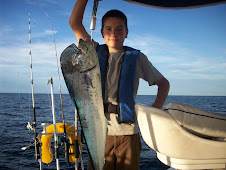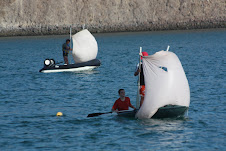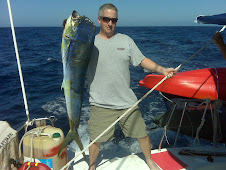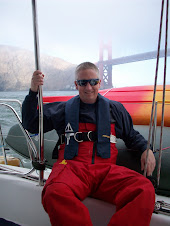We've been out here floating around in Mexico for 3 1/2 years now. We've heard of quite a few boats being lost in that time. Usually it's a simple mistake, not bad weather, that costs a sailboat. Last summer, the sailboat Aunt Sur was up in the northern Sea of Cortez when the single-handing owner fell asleep during a long passage and ended up on the rocks. He survived, but his boat was a total loss. I heard about another boat last year that was lost due to overconfidence. Two absolute newby sailors bought a sailboat and took it on a passage from Puerto Escondido to Mazatlan. Except, they ended up on the beach a hundred or so miles north of Mazatlan. They bought and lost their boat in a two week period, but they survived. Accidents/bad luck/bad charts/lack of sleep/bad decisions - all sorts of things can and do happen to cruisers down here in Mexico. Usually the highest price paid is that the boat is lost, the people are fine.
And then there's the story of the sail boat Finesse. Finesse was a 27 foot sailboat with a single-handing owner, named Donn Pinkney. Finesse left Manzanillo here on the Mexican mainland on February 20th, on her way to Zihuatanejo. The boat was found about a week later washed up on a beach, stripped of anything portable at a place called Ticla. The owner was never found. Later, it was reported on the radio nets that the boat had been seen at anchor in Ticla, a surfing beach but not known as an anchorage. Donn was relatively young, fit, active and in good health. By all accounts he was a surfer, a swimmer and a sailor. There were no adverse weather conditions anytime that week. And he is gone, at anchor, in mild conditions, boat lost. It's a scary story that doesn't make any sense.
The crew of Just a Minute had a reason to care for the story of Finesse. While I was in Iowa, Patrick and Jack took JaM north from Zihuatanejo to meet me in Manzanillo. JaM left Zihuatanejo on February 22nd - following the exact opposite course of Finesse in the same time period. On February 24th, JaM anchored in Maruata. Within minutes of anchoring, a beautiful woman on a surfboard swam out to JaM and asked if they had seen a sailboat named Finesse. When they said "no" and told her that they had come from Zihuatanejo, she began to cry. Her name was Berenice and she was a good friend of Donn's. Finesse was overdue and Berenice had started from Manzanillo working her way down the coast to find Donn. With Patrick's answer, she knew that something had happened to her friend. She was bereft. Seeing the grief of a loved one made the story personal to us.
That night, February 24th, Patrick put out a "Health and Welfare" call for Finesse on the SSB radio Southbound Net. A Health and Welfare call is simply a way to let the cruising community know to be on the lookout for a vessel since someone is concerned for them. Often, a Health and Welfare call will be met with immediate information from someone who is anchored nearby or who has seen them recently. No one had any information that night. No one seemed to have even heard of the boat or met the owner. Over the following days, the Health and Welfare calls were repeated on the Southbound, Amigo and Sonrisa nets, reaching well over a hundred boats, but no one had any real information to give regarding Finesse. No one knew his planned stops on his trip to Zihuatanejo, or if he was going to do a straight shot. It was several more days until his boat was reported found at Ticla. By then it had been stripped of everything, further obscuring what had happened.
The story really concerns me for a couple reasons. We've been doing the exact same thing, in the same place, in the same time period and at no time have I ever felt threatened or at danger from anything. I would have thought the dangers of cruising the Pacific Coast of mainland Mexico were dealing with big ocean swell, lots of container ship traffic, and a greater danger of theft since there are so many people living here.
And then there's the story of the sail boat Finesse. Finesse was a 27 foot sailboat with a single-handing owner, named Donn Pinkney. Finesse left Manzanillo here on the Mexican mainland on February 20th, on her way to Zihuatanejo. The boat was found about a week later washed up on a beach, stripped of anything portable at a place called Ticla. The owner was never found. Later, it was reported on the radio nets that the boat had been seen at anchor in Ticla, a surfing beach but not known as an anchorage. Donn was relatively young, fit, active and in good health. By all accounts he was a surfer, a swimmer and a sailor. There were no adverse weather conditions anytime that week. And he is gone, at anchor, in mild conditions, boat lost. It's a scary story that doesn't make any sense.
The crew of Just a Minute had a reason to care for the story of Finesse. While I was in Iowa, Patrick and Jack took JaM north from Zihuatanejo to meet me in Manzanillo. JaM left Zihuatanejo on February 22nd - following the exact opposite course of Finesse in the same time period. On February 24th, JaM anchored in Maruata. Within minutes of anchoring, a beautiful woman on a surfboard swam out to JaM and asked if they had seen a sailboat named Finesse. When they said "no" and told her that they had come from Zihuatanejo, she began to cry. Her name was Berenice and she was a good friend of Donn's. Finesse was overdue and Berenice had started from Manzanillo working her way down the coast to find Donn. With Patrick's answer, she knew that something had happened to her friend. She was bereft. Seeing the grief of a loved one made the story personal to us.
That night, February 24th, Patrick put out a "Health and Welfare" call for Finesse on the SSB radio Southbound Net. A Health and Welfare call is simply a way to let the cruising community know to be on the lookout for a vessel since someone is concerned for them. Often, a Health and Welfare call will be met with immediate information from someone who is anchored nearby or who has seen them recently. No one had any information that night. No one seemed to have even heard of the boat or met the owner. Over the following days, the Health and Welfare calls were repeated on the Southbound, Amigo and Sonrisa nets, reaching well over a hundred boats, but no one had any real information to give regarding Finesse. No one knew his planned stops on his trip to Zihuatanejo, or if he was going to do a straight shot. It was several more days until his boat was reported found at Ticla. By then it had been stripped of everything, further obscuring what had happened.
The story really concerns me for a couple reasons. We've been doing the exact same thing, in the same place, in the same time period and at no time have I ever felt threatened or at danger from anything. I would have thought the dangers of cruising the Pacific Coast of mainland Mexico were dealing with big ocean swell, lots of container ship traffic, and a greater danger of theft since there are so many people living here.
One of the reasons I've always felt comfortable cruising the coast is because there are hundreds of other cruisers here. There are fewer anchorages over a greater stretch of land and so there are usually other boats nearby. Rarely will you ever find yourself alone in an anchorage. There's safety in numbers and the other cruisers act like a safety net. Over this season, we've heard of several cruisers using the cruiser net of "friends" to get help with a tow into an anchorage when their engine died. The net of cruisers was also there in Zihua during the thefts that happened; cruisers knew about and actively took part in the situation. In Barra this season, a group of cruisers stopped a dragging boat and reanchored it, even though no one was on board. It gives me a little ease knowing that when I leave my boat to go to shore, there are other cruisers in the anchorage kind of "keeping an eye" on things. It's not a sure-fire deterrent for theft on this busy, crowded coast, but it helps.
Regardless of whether Finesse and her captain were brought down by foul play or just bad anchoring, the story reaffirmed one lesson for me. You're safer if you are part of the net. After hearing this story, we will continue to only use known anchorages on the coast. If you are sharing anchorages, the safety net of your fellow cruisers is around you. Can being part of the net stop bad things from happening? - No. But it's nice to know you aren't alone, and that people will know of your troubles more quickly, and that they might be able to help.
And more importantly, we will keep checking in on the SSB and VHF radio nets. The more cruisers who know who you are, where you've been, and where you are going, even if they've never personally met you, I think the safer you are down here on the coast, or anywhere. Every check-in on an SSB net is written down and recorded, for your safety. If you go missing, they at least have a record of when and where you last were, which is invaluable for someone trying to find you.
My heart goes out to Donn's family and friends. How I wish that Donn's experience on the coast was like mine. For me it's been beautiful, lively, full of people and fun and no worries. It's hard for me to comprehend how dangerous this place can be, too.

















What a terribly sad and mysterious story, Laura. I hope for his family and friends (no to mention the cruising community) that answers are found.
ReplyDeleteIt's been a month, and as far as I can find on the internet, there are still no answers. It is so sad.
ReplyDeleteLaura
Wow, so sad and heartbreaking. Hopefully some answers will come to light in time and bring some needed closure to Donn's friends, family and the cruising community.
ReplyDelete